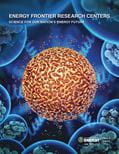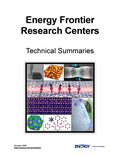Transformative Opportunities

In 2014, the Department of Energy's Office of Science charged the Basic Energy Sciences Advisory Committee (BESAC) to assess the progress made on the five Grand Challenges identified in the 2007 BESAC report, Directing Matter and Energy: Five Challenges for Science and the Imagination, and determine what new knowledge opportunities exist to advance energy science. The findings are given in a 2015 report, Challenges at the Frontiers of Matter and Energy: Transformative Opportunities for Discovery Science. This report highlights striking recent discoveries made in pursuit of the Grand Challenges that open compelling new research directions with the potential to transform the methods, reach, and impact of energy science and technology. It also presents five new Transformative Opportunities that reflect the breakthrough potential of research supported by the Office of Basic Energy Sciences (BES). Each Energy Frontier Research Center addresses one or more of these transformative opportunities.
Transformative Opportunity #1:
Mastering Hierarchical Architectures and Beyond-Equilibrium Matter
A new horizon for materials design is the opportunity to precisely control the placement of atoms in order to form desirable hierarchical structures, which, in turn, deliver novel properties. Of particular promise is the ability to predict and control non-equilibrium structures which are prevalent in nature in synthetic systems.
Transformative Opportunity #2:
Beyond Ideal Materials and Systems: Understanding the Critical Roles of Heterogeneity, Interfaces, and Disorder
Real materials contain heterogeneity, interfaces, and disorder, which proliferate at the mesoscale and often control the macroscopic behavior of materials. Advances in simulation, synthesis, and characterization hold the promise of moving beyond the familiar ideal homogeneous systems to master these structural complexities, turning "defects" into new design tools. Such advances can lead to a transformative impact in energy materials used for solar and nuclear power, hydraulic fracturing, power conversion, airframes, and batteries.
Transformative Opportunity #3:
Harnessing Coherence in Light and Matter
Coherence in quantum mechanical phenomena is a powerful force with direct far-reaching macroscopic implications. Recent advances have greatly enhanced our ability to observe and control coherence in both light and matter. Success in developing and exploiting these advances could revolutionize fields as diverse as information processing, sensor technology, and energy generation through the control of the outcome of chemical reactions or the instantaneous state of a material.
Transformative Opportunity #4:
Revolutionary Advances in Models, Mathematics, Algorithms, Data, and Computing
The convergence of recent rapid advances in theoretical, mathematical, computational, and experimental capabilities promises to transform our ability to find, predict, and control new materials and chemical processes; understand complex matter across a range of length and time scales; and steer experiments toward deep scientific insights.
Transformative Opportunity #5:
Exploiting Transformative Advances in Imaging Capabilities across Multiple Scales
The maxim "seeing is believing" captures the value of visual observation. Recent advances in imaging capabilities across multiple scales now allow us to directly see complex structures, chemistry, and dynamics that were previously invisible. Exploiting these new imaging tools in multimodal contexts, we can accelerate the discovery of new materials and functionalities, the understanding of combustion and other chemical processes, and the development of innovative approaches to materials synthesis.









